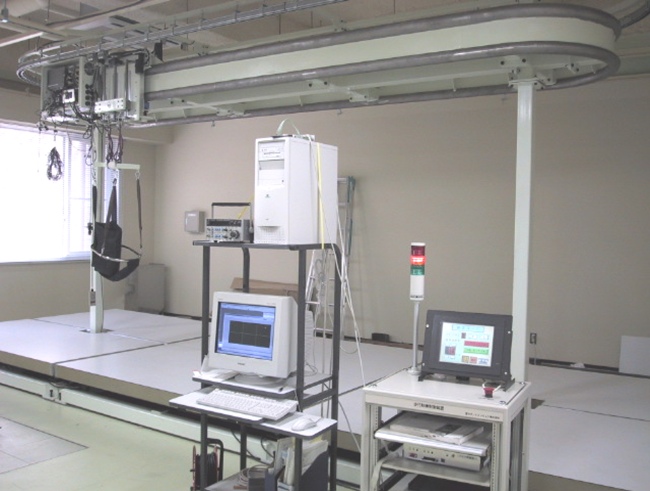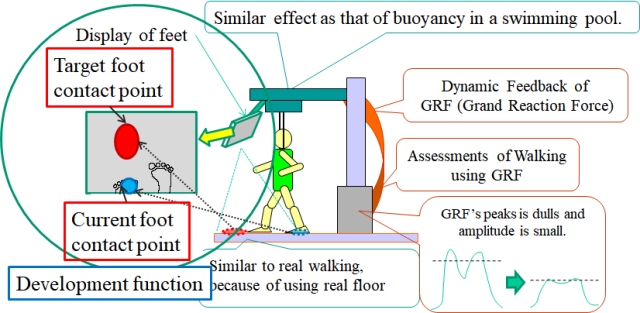Development of Gait Training System with Visual Feedback Function of Foot Contact Point
Rehabilitation training is one of the fields where mechatronics systems can provide effective tools for diagnosis of performance. Mechatronics systems can also decrease the physical load in physical therapy treatment, such as gait training. In addition, it can record training data and show results or conditions of training.
Feedback of results or conditions in training is considered to lead to more effective training compared to simple passive training system, since information stimulate brain function and trainee’s motivation is increase. Ohnishi et al. achieve a certain result on upper limb rehabilitation of cervical spinal cord injured patients1. Therefore, we consider that functions of data recording and displaying of training analysis results are essential for mechatronics training system.
Normally, training for a patient with enfeebled lower limb function uses parallel bars and pools. Parallel-bar training has the disadvantage of causing pain, and it requires strength in the upper limbs. Training in a heated swimming pool is easier on the trainee’s body. However, it also has drawbacks, which are the scale and maintenance of the facility, as well as the stress on the therapist resulting from the safety in the pool.
Several gait-training devices with slinging mechanism have been reported2-4. A treadmill device is a popular mechanism because of its easy-installation and ease-of-use. Though, this method lacks the sense of dynamic body movement since acceleration of the body in the direction of movement is canceled. Another disadvantage of a static support of the body weight, seen in other systems, is that it limits the rhythm of the movement and cannot reduce the impact force at foot contact. To overcome these problems, our system was developed.

The main feature of the system is constant dynamic adjustment of the tension lifting the trainee based on information from a ground reaction force. The load on the trainee’s foot touching the ground is regularly maintained at a low-burden level. The trainee senses the stimulation on the sole and other parts of the body as in a natural walk, since he or she is walking on the force plate, a solid surface. Furthermore, a trainee can train in various surface environments, for example, a slope, by changing the surface on the force plate.
The technical goal of developing our Gait Training System is to provide a training device that obtains a similar effect as that of buoyancy in a swimming pool. In our system, a slinging device supports the trainee while he or she walks on force plates. The lifting power of the slinging system is constantly controlled during the training by the information obtained from the force plates. Ground reaction force is similar to in water by this control because its peaks is dulling, and amplitude is small.
Therefore, this system constantly provides the most reasonable load level to the trainee by adjusting the lifting force according to the trainee’s degree of recovery. Moreover, the system provides a tool for evaluating the effect of training by displaying the training records and the force plate data. In the future, we aim to develop the human adapted gait training system which diagnose the degree of recovery and give the optimum load to trainee automatically.
We reported the outline of our system and the results of the tests by several aged and also handicapped person5. And we developed new force sensor and expressed the effects to walking posture by setting the display6,7. However, the more high-accuracy control system is required in order to realize above goal. So we conducted experiments to slinging system identification and estimate model parameter from experiment results, and we developed the simulation of sling system. Moreover, the model of Gait Training System that include human was proposed and application of control system design is considered8,9.
Now, we investigate about the visual feedback function. In visual feedback function, we show estimate method of foot contact point using the application point of reaction force, and the results of overlaying with foot contacted point and target contact point on trainee’s foot picture by video camera.
